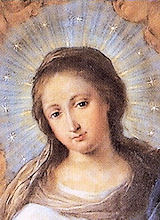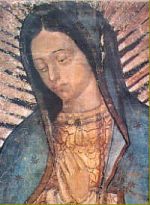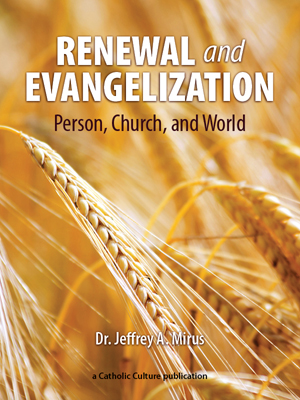Subscribe for free today!
Get newsletters with the latest content, and access to exclusive ebooks and podcast episodes.
Already subscribed? Log in to stop seeing invitations to subscribe.
May 2025 — Overview for the Month
The Easter season is represented by the liturgical color white — the color of light, a symbol of joy, purity and innocence (absolute or restored). The season ends on Pentecost, June 8th, so the whole month of May is in the Easter season.
The Holy Father's Intentions for the Month of May 2025
For the use of the new technologies: Let us pray that the use of the new technologies will not replace human relationships, will respect the dignity of the person, and will help us face the crises of our times. (See also The Pope's Prayer Intentions.)
Feasts for May
1. Joseph the Worker, Opt. Mem.
2. Athanasius, Memorial
3. Philip and James, Apostles, Feast
4. THIRD SUNDAY OF EASTER, Sunday
10. Damien de Veuster (USA); John of Avila, Opt. Mem.
11. FOURTH SUNDAY OF EASTER (GOOD SHEPHERD SUNDAY), Sunday
12. Nereus and Achilleus; Pancras, Martyrs, Opt. Mem.
13. Our Lady of Fatima, Opt. Mem.
14. Matthias, Apostle, Feast
15. Isidore the Farmer (USA), Opt. Mem.
18. FIFTH SUNDAY OF EASTER, Sunday
20. Bernardine of Siena, Opt. Mem.
21. Christopher Magallanes & Companions, Opt. Mem.
22. Rita of Cascia, Opt. Mem.
25. SIXTH SUNDAY OF EASTER, Sunday
26. Philip Neri; Minor Rogation Day, Memorial
27. Augustine of Canterbury; Minor Rogation Day, Opt. Mem.
29. Pope Paul VI, Optional Memorial or SOLEMNITY OF THE ASCENSION,
31. Visitation of the Blessed Virgin Mary, Feast
Focus of the Liturgy
The Gospel readings for May are taken from St. Luke and St. John. All are from Cycle C, Weekdays Year 2.
| May 4 | Cycle C, John 21:1-19: Jesus came and took the bread and gave it to them, and in like manner the fish.
|
| May 11 | Cycle C: John 10:27-30: I give my sheep eternal life.
|
| May 18 | Cycle C, John 13:31-33a, 34-35: I give you a new commandment: love one another.
|
| May 25 | Cycle C, John 14:23-29: The Holy Spirit will teach you everything and remind you of all that I told you.
|
Highlights of the Month 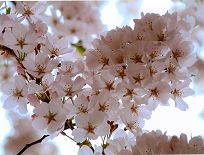 As Spring blossoms forth and we are surrounded by new life, we spend this month full of the joy of our Easter celebration and in anticipation of the coming of the Holy Spirit, our Consoler and Advocate on Pentecost (June 8).
As Spring blossoms forth and we are surrounded by new life, we spend this month full of the joy of our Easter celebration and in anticipation of the coming of the Holy Spirit, our Consoler and Advocate on Pentecost (June 8).
The saints that we will focus on this month—those who have already shared in the rewards of the Resurrection—are:
St. Joseph the Worker (May 1),
St. Athanasius (May 2),
Sts. Philip and James (May 3),
St. Damien de Vuesterand John of Avila (May 10),
St. Nereus & Achilleus, St. Pancras (May 12),
Our Lady of Fatima (May 13),
St. Matthias (May 14), St. Isidore the Farmer (May 15),
St. Bernadine of Siena (May 20),
St. Christopher Magallanes (May 21),
St. Rita of Cascia (May 22),
St. Philip Neri (May 26),
St. Augustine of Canterbury (May 27),
and the Visitation of the Blessed Virgin Mary (May 31).
The feasts of St. John I (May 18), and St. Bede, St. Gregory VII and St. Mary Magdalene de Pazzi (May 25), are superseded by the Sunday liturgy. The Solemnity of the Ascension (May 29) is celebrated on June 1 (Sunday) in most dioceses in the United States.
A Time of Grace 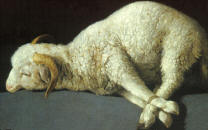 The world is resplendent with Spring's increased light and new growth. It is Mary's month in the Easter season and all of nature rejoices with the Queen of heaven at the Resurrection of the Son she was worthy to bear. During the remainder of Easter time, let us endeavor through the prayers of the Holy Liturgy and the Holy Rosary to deepen our gratitude for the mystery of our Baptismal rebirth in Christ.
The world is resplendent with Spring's increased light and new growth. It is Mary's month in the Easter season and all of nature rejoices with the Queen of heaven at the Resurrection of the Son she was worthy to bear. During the remainder of Easter time, let us endeavor through the prayers of the Holy Liturgy and the Holy Rosary to deepen our gratitude for the mystery of our Baptismal rebirth in Christ.
"The month of May, with its profusion of blooms was adopted by the Church in the eighteenth century as a celebration of the flowering of Mary's maidenly spirituality...With its origins in Isaiah's prophecy of the Virgin birth of the Messiah under the figure of the Blossoming Rod or Root of Jesse, the flower symbolism of Mary was extended by the Church Fathers, and in the liturgy, by applying to her the flower figures of the Sapiential Books—Canticles, Wisdom, Proverbs and Sirach.
"In the medieval period, the rose was adopted as the flower symbol of the Virgin Birth, as expressed in Dante's phrase, 'The Rose wherein the Divine Word was made flesh,' and depicted in the central rose windows of the great gothic cathedrals-from which came the Christmas carol, 'Lo, How a Rose 'ere Blooming.' Also, in the medieval period, when monasteries were the centers of horticultural and agricultural knowledge, and with the spread of the Fransiscan love of nature, the actual flowers themselves, of the fields, waysides and gardens, came to be seen as symbols of Mary..." —John S. Stokes
 "In the hierarchy of holiness it is precisely the 'woman', Mary of Nazareth, who is the 'figure' of the Church. She 'precedes' everyone on the path to holiness; in her person 'the Church has already reached that perfection whereby she exists without spot or wrinkle'". —John Paul II Mulieris Dignitatem, 1988
"In the hierarchy of holiness it is precisely the 'woman', Mary of Nazareth, who is the 'figure' of the Church. She 'precedes' everyone on the path to holiness; in her person 'the Church has already reached that perfection whereby she exists without spot or wrinkle'". —John Paul II Mulieris Dignitatem, 1988This item 12548 digitally provided courtesy of CatholicCulture.org


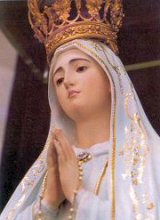
 May 29 or June 1
May 29 or June 1


 It was to St. Philip that Christ addressed his remark concerning the feeding of the multitude. The roundels represent two loaves of bread.
It was to St. Philip that Christ addressed his remark concerning the feeding of the multitude. The roundels represent two loaves of bread.
 Chosen, by lot, to replace Judas Iscariot, St. Matthias served as a missionary in Judaea, where he is said to have been stoned and beheaded. A battle axe with silver head and tawny handle, white open book with inscription "super Mathiam."
Chosen, by lot, to replace Judas Iscariot, St. Matthias served as a missionary in Judaea, where he is said to have been stoned and beheaded. A battle axe with silver head and tawny handle, white open book with inscription "super Mathiam." The fleur-de-lys is a symbol for the Blessed Virgin Mary and is derived from the Madonna's lily.
The fleur-de-lys is a symbol for the Blessed Virgin Mary and is derived from the Madonna's lily.